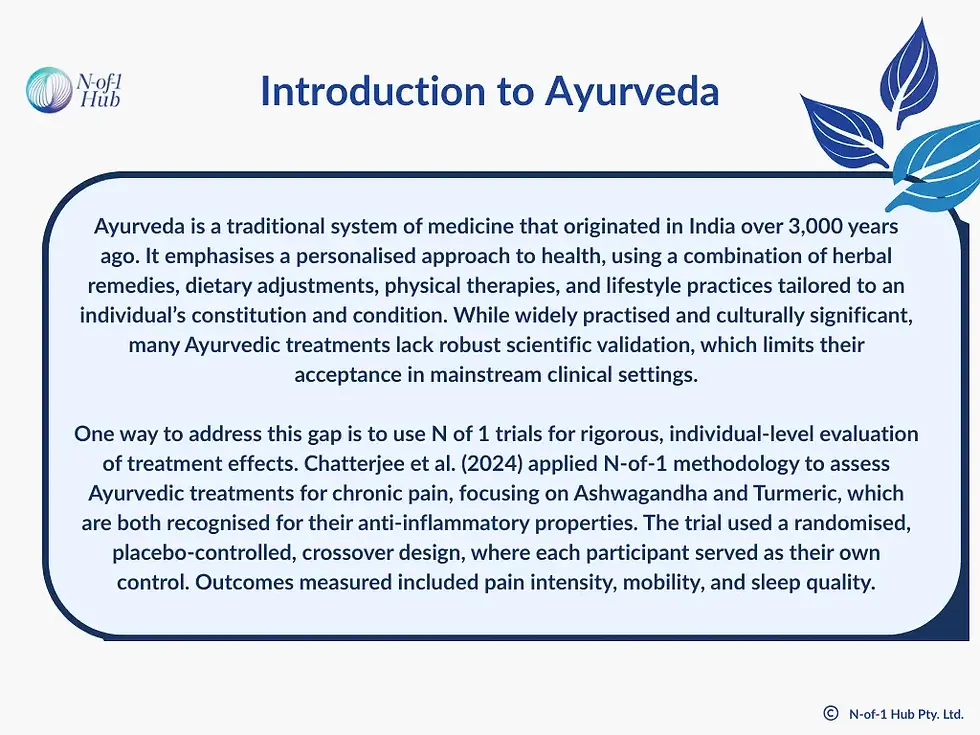Bringing Science to Naturopathy through N of 1 Trials and SCEDs
- N-of-1 Hub

- Jun 18
- 7 min read

In recent years, the bridge between traditional medicine and naturopathy has started to strengthen. Many practitioners working in the field of naturopathy are eager to see how scientific methodologies can validate and enhance naturopathic practice. This article explores how N of 1 trials and Single Case Experimental Designs (SCEDs) can revolutionise naturopathic practice. By the end of this article, you will understand how N of 1 trials and SCEDs work in the context of naturopathy, the benefits they bring, and ways to overcome some obstacles in their application.
The Growing Appeal of Naturopathy
Naturopathy's popularity has surged as people seek natural and holistic ways to improve their health. The emphasis on natural remedies, lifestyle changes, and preventive care aligns well with the growing awareness of health and wellness. However, scepticism from mainstream medicine remains a challenge, so despite its benefits, naturopathy often struggles to gain recognition from the scientific community. While anecdotal and traditional evidence abounds, there is a need for rigorous, scientific validation to gain broader acceptance. This is where N of 1 trials and Single Case Experimental Designs come into play.
Why use N of 1 Trials and Single Case Experimental Designs in Naturopathy?
N of 1 trials and Single Case Experimental Designs are particularly well-suited to naturopathy due to their ability to test personalised, multi-faceted treatments that are central to this field. Naturopathic medicine often involves combining various modalities, such as herbal remedies, nutrition, and lifestyle interventions, making traditional large-scale clinical trials difficult to implement effectively. N of 1 trials and other single case experimental designs allow individual patients to serve as their own control, testing personalised interventions over time in a structured and often randomised manner. These methods are especially valuable for assessing complex, real-world outcomes, such as symptom relief, quality of life, and physiological changes, within the patient’s everyday environment. These approaches are flexible and iterative, allowing for real-time adjustments based on patient data. This methodological flexibility and emphasis on individual response align closely with the holistic, personalised nature of naturopathic medicine, providing a rigorous way to evaluate treatments that are often unsuitable for traditional group-based trials.
To illustrate the practical application of these methods in naturopathic contexts, the following examples demonstrate how N of 1 trials and SCEDs have been used to evaluate individual responses to common naturopathic treatments across various conditions.
Real World Example 1: Valerian
One example of how N of 1 trials can enhance naturopathic care comes from a study examining the effects of valerian on chronic insomnia. Valerian is a well-known herbal remedy that has been studied for its ability to improve sleep quality, but its effectiveness can vary significantly between individuals. In a series of N of 1 trials, researchers examined the effects of valerian on patients with chronic insomnia, using a randomised, double-blind, placebo-controlled crossover N of 1 trial design. Each patient alternated between taking valerian and placebo, with outcome measures such as sleep onset latency, total sleep time, and sleep quality being tracked. The results showed that valerian improved sleep outcomes in some patients but not in others, highlighting variability in individual responses to herbal medicines. For instance, one participant experienced a significant reduction in the time it took to fall asleep, while another reported minimal sleep changes when on valerian compared to placebo. This study underscored the value of N of 1 trials in naturopathic practice, allowing practitioners to tailor treatments based on empirical data from an individual. By applying these personalised trial methods, naturopaths can offer evidence-based, customised treatments that are effective for each patient.
Real World Example 2: Ayurveda

While randomised controlled trials (RCTs) have demonstrated the effectiveness of turmeric for knee pain and certain Ayurvedic formulations for glycaemic control, N of 1 trials offer additional benefits. They can provide personalised insights that help determine whether a treatment is effective for a specific individual, thereby enhancing both clinical relevance and patient engagement. In this way, N of 1 trials can strengthen the scientific foundation of Ayurvedic practice while preserving its inherently individualised approach.
Real World Example 3: Probiotics
Probiotics are commonly used in naturopathic practice for their potential to reduce inflammation and support overall health, but their effectiveness can vary from person to person. To explore how probiotics might help manage chronic pain, Taye et al. (2020) conducted an N of 1 trial to assess the effects of a multi-strain probiotic in a patient with osteoarthritis. The study used a randomised, double-blind, placebo-controlled crossover N of 1 design, allowing the participant to alternate between periods of taking the probiotic and placebo. Key outcomes, including pain intensity, physical function, and quality of life, were tracked throughout the trial. The results showed that the probiotic led to notable improvements in pain and mobility during some phases, while in other individuals, benefits were minimal. This kind of individual variability highlights the importance of tailoring treatments, which is a central tenet of naturopathic care.
Single-Case Experimental Designs (often referred to as SCEDs) are also valuable for evaluating naturopathic interventions in real-world contexts. They are particularly well suited to situations where treatments, such as individualised herbal formulas, dietary prescriptions, or lifestyle changes, are highly personalised, may evolve over time, and often involve components with delayed or uncertain biological effects. These features can make such interventions difficult to evaluate using N of 1 trials, which typically require clearly defined, time-limited, and replicable treatment periods. SCEDs, by contrast, provide a more flexible framework for testing causal effects within individuals while accommodating the complexity and variability inherent in naturopathic care. This makes them especially useful for generating individual-level evidence to inform both clinical practice and research in naturopathy.
Overcoming Obstacles

While N of 1 trials and Single Case Experimental Designs offer considerable benefits in naturopathy, their implementation requires careful consideration and planning. These methods present an exciting opportunity to personalise treatment and generate valuable insights into individual patient responses. However, as with any innovative method, implementing these designs can present some practical challenges. These range from helping patients understand and engage with the process, to ensuring naturopaths can manage the time, resources, and data requirements effectively. The following sections outline key barriers and offer practical strategies to support successful implementation in naturopathic practice.
Educating Patients
Patients may be unfamiliar with N of 1 trials or Single Case Experimental Designs, which can lead to hesitation or uncertainty about taking part in one. It is important to take the time to clearly explain the process, including how the trial works, what will be expected of them, and how their involvement can lead to more personalised care. Emphasising that these designs are tailored to the individual and that the data collected is directly relevant to their own treatment can help build motivation to take part. Providing simple, relatable examples and using visual aids can make the concept more accessible. This kind of proactive education empowers patients to see themselves as active contributors to their care, rather than passive recipients, which aligns strongly with the collaborative values of naturopathic medicine.
Limited Resources and Time
Implementing N of 1 trials or Single Case Experimental Designs in naturopathic practice can be difficult, particularly for clinicians working with limited resources or under time pressure. Structured data collection and analysis can be time-intensive, especially for solo practitioners or small teams. The absence of dedicated software can also make manual outcome tracking burdensome. However, starting with simple tools like Google Forms, spreadsheets, or smartphone symptom tracking apps can provide a manageable entry point. Over time, practitioners can develop more streamlined systems suited to their workflows. Collaboration with colleagues or research partners can also ease the burden and bring additional expertise to the process.
Data Interpretation Challenges
Naturopaths may find it difficult to interpret data from N of 1 trials or Single Case Experimental Designs, particularly if they lack training in statistical analysis. Identifying patterns, drawing valid conclusions, and ensuring the results are meaningful and clinically useful requires more than just collecting data; it requires a foundational level of data literacy. Building confidence in basic data interpretation skills, or partnering with someone who has relevant expertise can significantly enhance the ability to interpret and apply trial results in practice.
Navigating Dual Roles: Practitioner and Researcher
Another challenge is balancing the role of practitioner and researcher. Naturopaths may find it difficult to juggle patient care with the requirements of conducting a trial, such as designing the study, choosing lengths of treatment periods and selecting what outcomes to measure and how to measure them. Striking this balance requires careful planning and possibly adjusting appointment schedules to ensure that neither patient care nor trial integrity is compromised. Gradually building this balance into daily practice can help make the process more manageable.
As Bradbury et al. (2020) argue, applying N of 1 trials in complementary medicine can help redefine research standards by linking individualised care with rigorous evidence. While N of 1 trials focus on evaluating a single intervention in one patient using randomised, controlled conditions, Single Case Experimental Designs offer a broader methodological framework that can include multiple treatment phases, non-randomised sequences, or varying outcomes over time. Single Case Experimental Designs allow naturopaths to systematically assess interventions, monitor change, and adapt care based on structured, individual-level evidence. N of 1 trials and Single Case Experimental Designs support the shift toward evidence-based practice in Complementary and Alternative Medicine, enabling practitioners to justify personalised treatments using credible, evidence-based data. By embedding these studies in routine practice, naturopathy can strengthen its scientific foundation while preserving the tailored, holistic care central to the discipline.
Getting started with N of 1 trials and Single Case Experimental Designs
If you’re a naturopath seeking to integrate N of 1 trials and Single-Case Experimental Designs (SCEDs) into your practice, N-of-1 Hub provides expert-led training and tailored consulting to support you every step of the way. Our programs are designed to build your confidence in designing, running, and interpreting these powerful studies - even if you have no prior research experience. Whether you’re aiming to evaluate herbal protocols, lifestyle interventions, or complex multimodal treatments, we’ll equip you with the practical tools to generate rigorous, patient-specific evidence.
Book a free consultation today to discover how personalised research methods can strengthen your clinical decisions, increase patient trust, and position your naturopathic practice at the forefront of evidence-based care.




